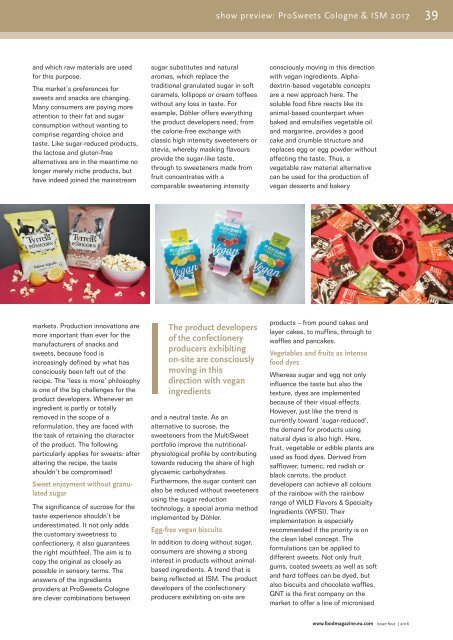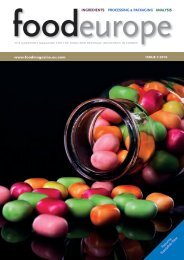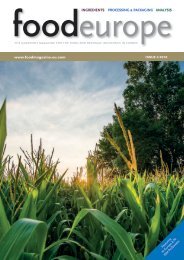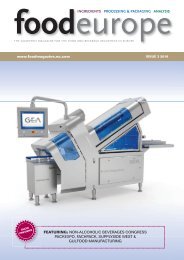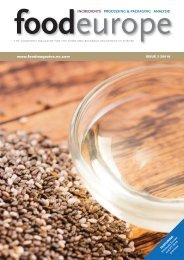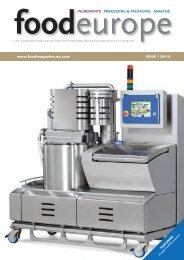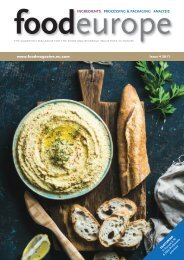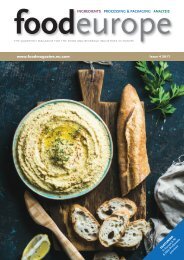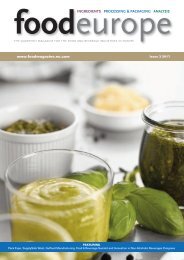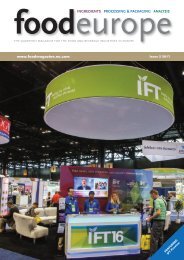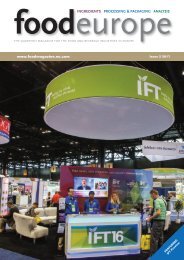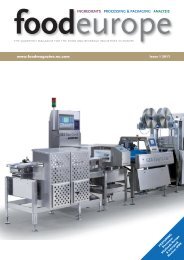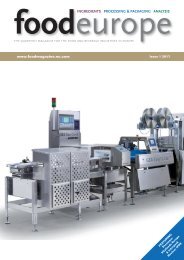FoodEurope Issue 4 2016
Create successful ePaper yourself
Turn your PDF publications into a flip-book with our unique Google optimized e-Paper software.
show preview: ProSweets Cologne & ISM 2017 39<br />
and which raw materials are used<br />
for this purpose.<br />
The market’s preferences for<br />
sweets and snacks are changing.<br />
Many consumers are paying more<br />
attention to their fat and sugar<br />
consumption without wanting to<br />
comprise regarding choice and<br />
taste. Like sugar-reduced products,<br />
the lactose and gluten-free<br />
alternatives are in the meantime no<br />
longer merely niche products, but<br />
have indeed joined the mainstream<br />
sugar substitutes and natural<br />
aromas, which replace the<br />
traditional granulated sugar in soft<br />
caramels, lollipops or cream toffees<br />
without any loss in taste. For<br />
example, Döhler offers everything<br />
the product developers need, from<br />
the calorie-free exchange with<br />
classic high intensity sweeteners or<br />
stevia, whereby masking flavours<br />
provide the sugar-like taste,<br />
through to sweeteners made from<br />
fruit concentrates with a<br />
comparable sweetening intensity<br />
consciously moving in this direction<br />
with vegan ingredients. Alphadextrin-based<br />
vegetable concepts<br />
are a new approach here. The<br />
soluble food fibre reacts like its<br />
animal-based counterpart when<br />
baked and emulsifies vegetable oil<br />
and margarine, provides a good<br />
cake and crumble structure and<br />
replaces egg or egg powder without<br />
affecting the taste. Thus, a<br />
vegetable raw material alternative<br />
can be used for the production of<br />
vegan desserts and bakery<br />
markets. Production innovations are<br />
more important than ever for the<br />
manufacturers of snacks and<br />
sweets, because food is<br />
increasingly defined by what has<br />
consciously been left out of the<br />
recipe. The ‘less is more’ philosophy<br />
is one of the big challenges for the<br />
product developers. Whenever an<br />
ingredient is partly or totally<br />
removed in the scope of a<br />
reformulation, they are faced with<br />
the task of retaining the character<br />
of the product. The following<br />
particularly applies for sweets: after<br />
altering the recipe, the taste<br />
shouldn’t be compromised!<br />
Sweet enjoyment without granulated<br />
sugar<br />
The significance of sucrose for the<br />
taste experience shouldn’t be<br />
underestimated. It not only adds<br />
the customary sweetness to<br />
confectionery, it also guarantees<br />
the right mouthfeel. The aim is to<br />
copy the original as closely as<br />
possible in sensory terms. The<br />
answers of the ingredients<br />
providers at ProSweets Cologne<br />
are clever combinations between<br />
The product developers<br />
of the confectionery<br />
producers exhibiting<br />
on-site are consciously<br />
moving in this<br />
direction with vegan<br />
ingredients<br />
and a neutral taste. As an<br />
alternative to sucrose, the<br />
sweeteners from the MultiSweet<br />
portfolio improve the nutritionalphysiological<br />
profile by contributing<br />
towards reducing the share of high<br />
glycaemic carbohydrates.<br />
Furthermore, the sugar content can<br />
also be reduced without sweeteners<br />
using the sugar reduction<br />
technology, a special aroma method<br />
implemented by Döhler.<br />
Egg-free vegan biscuits<br />
In addition to doing without sugar,<br />
consumers are showing a strong<br />
interest in products without animalbased<br />
ingredients. A trend that is<br />
being reflected at ISM. The product<br />
developers of the confectionery<br />
producers exhibiting on-site are<br />
products – from pound cakes and<br />
layer cakes, to muffins, through to<br />
waffles and pancakes.<br />
Vegetables and fruits as intense<br />
food dyes<br />
Whereas sugar and egg not only<br />
influence the taste but also the<br />
texture, dyes are implemented<br />
because of their visual effects.<br />
However, just like the trend is<br />
currently toward ‘sugar-reduced’,<br />
the demand for products using<br />
natural dyes is also high. Here,<br />
fruit, vegetable or edible plants are<br />
used as food dyes. Derived from<br />
safflower, tumeric, red radish or<br />
black carrots, the product<br />
developers can achieve all colours<br />
of the rainbow with the rainbow<br />
range of WILD Flavors & Specialty<br />
Ingredients (WFSI). Their<br />
implementation is especially<br />
recommended if the priority is on<br />
the clean label concept. The<br />
formulations can be applied to<br />
different sweets. Not only fruit<br />
gums, coated sweets as well as soft<br />
and hard toffees can be dyed, but<br />
also biscuits and chocolate waffles.<br />
GNT is the first company on the<br />
market to offer a line of micronised<br />
www.foodmagazine.eu.com issue four | <strong>2016</strong>


